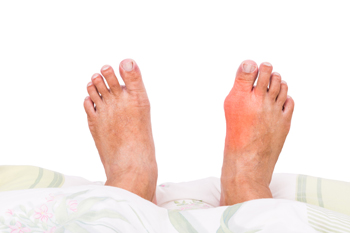(410) 764-7044
6506 Reisterstown Road, Baltimore
1205 York Road, Lutherville
6305 Belair Road, Baltimore
7809 Wise Avenue, Dundalk
What Is a Tailor’s Bunion?
Monday, 28 December 2020 00:00 A Tailor’s bunion, sometimes called a bunionette, is similar to a regular bunion. However, a Tailor’s bunion forms on the 5th metatarsophalangeal joint (or the “pinky toe”) instead of the big toe. Tailor’s bunions are most commonly caused by poorly fitting footwear, as well as structural foot problems. They appear as a swollen and hard bump on the outside of the foot next to the big toe, and they generally form over a long period of time and may not become painful for a while. Treatment options that a podiatrist may suggest include surgically removing the bunion, a corticosteroid injection to reduce swelling, and padding or orthotics to reduce pain. If you are dealing with pain that may be a Tailor’s bunion, be sure to consult with a podiatrist for a proper diagnosis and treatment.
A Tailor’s bunion, sometimes called a bunionette, is similar to a regular bunion. However, a Tailor’s bunion forms on the 5th metatarsophalangeal joint (or the “pinky toe”) instead of the big toe. Tailor’s bunions are most commonly caused by poorly fitting footwear, as well as structural foot problems. They appear as a swollen and hard bump on the outside of the foot next to the big toe, and they generally form over a long period of time and may not become painful for a while. Treatment options that a podiatrist may suggest include surgically removing the bunion, a corticosteroid injection to reduce swelling, and padding or orthotics to reduce pain. If you are dealing with pain that may be a Tailor’s bunion, be sure to consult with a podiatrist for a proper diagnosis and treatment.
If you are suffering from bunion pain, contact one of our podiatrists of Plaza Podiatry. Our doctors can provide the care you need to keep you pain-free and on your feet.
What Is a Bunion?
Bunions are painful bony bumps that usually develop on the inside of the foot at the joint of the big toe. As the deformity increases over time, it may become painful to walk and wear shoes. Women are more likely to exacerbate existing bunions since they often wear tight, narrow shoes that shift their toes together. Bunion pain can be relieved by wearing wider shoes with enough room for the toes.
Causes
- Genetics – some people inherit feet that are more prone to bunion development
- Inflammatory Conditions - rheumatoid arthritis and polio may cause bunion development
Symptoms
- Redness and inflammation
- Pain and tenderness
- Callus or corns on the bump
- Restricted motion in the big toe
In order to diagnose your bunion, your podiatrist may ask about your medical history, symptoms, and general health. Your doctor might also order an x-ray to take a closer look at your feet. Nonsurgical treatment options include orthotics, padding, icing, changes in footwear, and medication. If nonsurgical treatments don’t alleviate your bunion pain, surgery may be necessary.
If you have any questions, please feel free to contact our offices located in Baltimore, Lutherville, and Dundalk, MD . We offer the newest diagnostic and treatment technologies for all your foot care needs.




